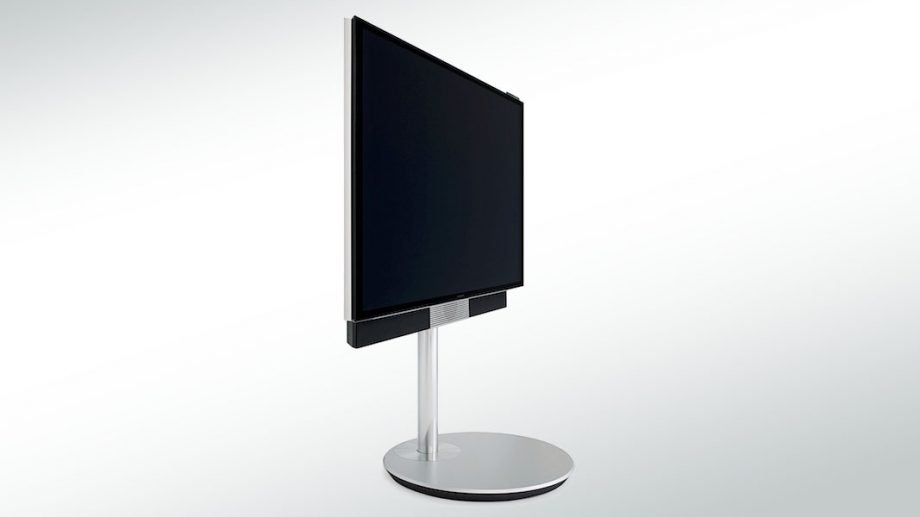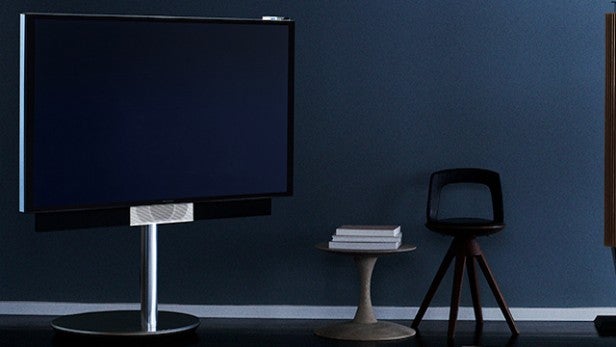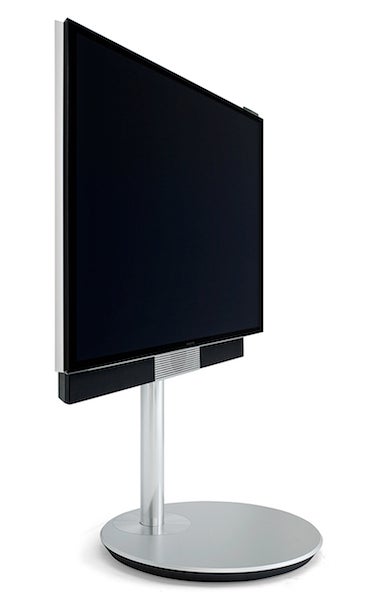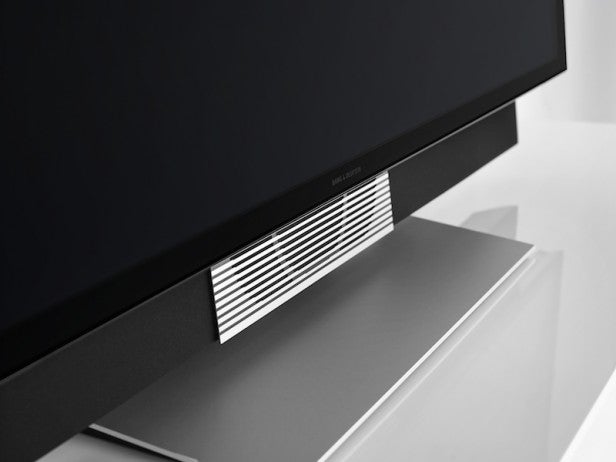Bang & Olufsen BeoVision Avant Review
Bang & Olufsen BeoVision Avant
B&O's first 4K TV is a thing of beauty

Sections
- Page 1 Bang & Olufsen BeoVision Avant Review
- Page 2 Picture Quality Review
- Page 3 3D, Sound Quality, and Conclusions Review
Verdict
Pros
- Gorgeous, heavily motorised design
- Excellent Picture Quality
- Astounding sound quality and flexibility
Cons
- Not much Smart TV content
- No 4K HEVC decoding built in
- No full v2.0 HDMI support
Key Specifications
- Review Price: £5995.00
- 55-inch LCD TV with edge LED lighting
- 4K/UHD native resolution
- Motorised stands and speakers
- Hugely powerful active speaker system
- Built-in support for adding full wired/wireless home cinema speaker package
What is the Bang & Olufsen BeoVision Avant?
The original B&O Avant was a CRT TV that’s now considered by some to be the finest CRT TV ever made. So it seems B&O is keen to channel this heritage and prestige into the new LCD Avant – a set which does mark, after all, a momentous point in the brand’s AV development given that it’s its first 4K/UHD TV.
Bang & Olufsen BeoVision Avant: Design and Features
As you would expect from B&O, the Avant doesn’t just trade on its name and native 4K resolution to define its luxury status. B&O has also gone to town in truly spectacular fashion on the set’s design.
The model we had in for test comprises a 55-inch screen (larger screen sizes are rumoured but not officially confirmed yet) fitted incredibly robustly onto a gorgeous aluminium pole stand, which itself sits at the edge of a simultaneously beautiful and heavy duty circular aluminium base.
The reason for the pole fitting at the edge of the base rather than at its centre becomes gloriously apparent as soon as you first switch the TV on after having it installed by one of B&O’s engineers (this is not a TV you’ll be expected to put together yourself!). The whole base starts to rotate, moving the TV away from the wall behind it.
This is striking enough, but it’s actually just the start of the Avant’s ‘poetry in motion’. For as the offset pole rotates round on the circular base, the TV also rotates around separately on the top of the pole. And still we’re not done, for slowly but surely you also witness a set of speakers sliding down out of the centre of the TV’s bottom edge – speakers which then remarkably telescope outwards to the left and right until they run almost the TV’s full width.
Plus, as the icing on the cake, the Avant’s picture opens out from the centre like a pair of curtains in perfect sync with the speakers stretching out from the TV’s centre.

All of this motion takes place beautifully smoothly and without a single squeak or grinding noise. In short, within 20 seconds B&O has completely established that the new Avant is a truly unique TV proposition with a build quality that’s in a whole other stratosphere to that of the ‘mainstream’ TV market.
Incredibly, given the level of motorisation inside the Avant, the pole floor stand is not the only mounting option available. There are also wall and table-top mounts – all of which also offer incredibly sophisticated motor functions.
And this is all before you’ve clocked the set’s other cool design trick: the way its ‘sandwich’-style frame and multi-layered rear panel, complete with aluminium top sheet, create an impression of the Avant being much slimmer around the back than it actually is.
The Avant also goes WAY beyond the usual call of TV duty with its connectivity. Starting with the basics, it carries six HDMIs – two more than we’ve seen on any other TV this year. Plus it’s got the usual integrated Wi-Fi and LAN network connectivity, and USBs for direct playback of multimedia from either connected computers or USB drives.
Where the Avant really blasts past mainstream TVs in connection terms, though, is with its audio and home automation/system integration features. On the audio side it’s capable of driving a frankly mental 21 channels. Eight of which, remarkably, can be delivered wirelessly. To make sure we didn’t forget this point, B&O provided a pair of its sensational BeoLab 20 wireless speakers with our Avant review sample. Though there are many other compatible speaker options in B&O’s arsenal too.
The Avant lets you establish up to nine multiple groupings for all the speakers it can drive, so you can deliver different audio effects (including 7.1-channel surround sound) and content to different zones in one room or multiple rooms. The interface for this speaker set up is superbly well designed – even though you’ll probably never have to touch it yourself given the B&O way of setting everything up for you!
SEE ALSO: The Best TVs of 2014
Even if you don’t add any extra speakers to the Avant, though, it’s uniquely talented from an audio perspective. Those drop-down speakers provide a three-channel system, with a dedicated centre speaker in the metallic central section, while a bass (.1) channel is provided by an upwardly venting 6.5-inch subwoofer on the TV’s rear. These built in speakers themselves can deliver an ear-mashing 240W of audio power – enough to humble even the sonic pyrotechnics of the class-leading Sony X9005B TVs.
The Avant is also capable of joining with and controlling any other B&O product compatible with the BeoLink system, meaning that if you attach, for instance, any B&O audio products (such as a radio) to the TV the two products will work as one.
Even more excitingly, with a connected BeoLink Gateway system the Avant can become part of an integrated home automation system comprising everything from light controllers, blinds, windows, heating and cooling systems to door locks, IP cameras and so on. Herein lies another way the Avant justifies its premium pricing.
Moving into the Avant’s picture specifications, the headline is, of course, that 4K native resolution. Given that the Avant had a development time of the best part of two years, we were pretty shocked – in a good way – when B&O revealed that its new TV had a 4K/UHD resolution. It was good to learn, too, that it delivers this from a VA-type panel with active 3D playback, rather than one of the IPS-type 4K panels we’ve found struggling with contrast this year.
It’s a pity no 3D glasses are included free with the Avant – especially as they will cost you a slightly steep £100 each to buy separately.
The new Avant also uses a new version of B&O’s Vision Clear picture technology that can adjust picture settings continually based on analysis of the incoming signals to deliver what B&O determines are the best results for the Avant’s panel. Normally we’re suspicious of these sorts of auto picture optimisation systems, finding they’re not nearly as clever as they think they are. But we were pretty impressed by how well the system worked on the BeoVision 11-40, especially where contrast was concerned. So we’ll definitely start out with the Avant’s Adaptive picture mode active, noting as we do so that other presets are available if Adaptive lets us down.
There’s a significant new element to the Avant’s automatic picture optimisation system, too. The key to this lies in the thin black bar protruding from the top right corner of the Avant’s frame, for contained within this are sensors able to detect not only the levels of light in your room but also the colour tones of that light. The sensor doesn’t just look forward, either; it delivers a 360-degree assessment of ambient conditions to enhance the accuracy of its related picture adjustments.
Again, though, if you’d rather always depend on your own picture settings or just don’t feel comfortable with the Room Adaptation system’s machinations, the option exists to either limit its activities with a ‘Basic’ setting that turns of its Chromatic analysis, or turn it off entirely.
While the Avant is unprecedentedly strong on automatic picture enhancements, though, it’s limited where manual ones are concerned. There isn’t a full colour management system of the sort we’d expect to find on a TV of the Avant’s ambition, and nor is there much control of the set’s motion processing (beyond a judder cancellation system) or any control over the local dimming system it applies to its LED lighting engine or the upscaling engine it applies to non-4K sources.
The only thing processing wise you can control beyond choosing whether to use the various automated picture optimisation tools is the TV’s noise reduction processing.
However, before the AV cognoscenti get too sniffy about the Avant’s shortage of manual calibration systems, let’s think back to the new Room Adaptation system comes in. For B&O’s engineers would argue with some justification that since the TV can now automatically assess your room conditions – including colour tone as well as light levels – and adjust its picture settings accordingly across 10 different drive levels for the R, G, B and white colour elements, then the need for the usual ‘on-location’ professional calibration is greatly reduced, if not entirely nullified.
We mentioned earlier that the Avant is the result of a nearly two-year development process – and unfortunately this has caused the set a couple of practical 4K problems. The worst of these is that it doesn’t carry built-in HEVC decoding, making Netflix 4K playback – and playback of other 4K streams, very likely – an impossibility.

Given that Netflix 4K is the only readily available 4K stream right now, not being able to access it on the Avant is a considerable blow.
The other 4K source limitation comes from the fact that the Avant only carries v1.4 HDMIs rather than the HDMI 2.0 ones supported by many rival 4K TVs this year. This means the Avant can’t currently take 4K feeds at frame rates higher than 30fps.
A firmware update is promised before the year is out that will allow 4K at higher frame rates, but only with reduced colour resolution.
The bottom line, though, is that you’ll essentially have to end up relying on future external boxes for 4K on the Avant. The Avant even goes so far as to include space within its connections ‘bay’ for an Apple TV box. Of course, though, at the moment Apple TV is HD only, not 4K, and Apple has said nothing about a 4K version appearing any time soon.
The last key feature element of the Avant is its smart TV service. And it’s a disappointment, to be honest. Selecting Webmedia from the input list calls up a smart menu that’s instantly recognisable as being powered by the Philips Net TV platform. Which isn’t great news because this platform is seriously lacking in content versus the smart offerings of most of the other key TV brands this year.
Aside from an impressively well-integrated Internet Radio ‘tuner’, the only highlights of the B&O smart engine are the BBC iPlayer, YouTube, Spotify, Facebook, iConcerts, Picasa, Euronews. There’s no ITV Player, no 4OD, no Demand 5, no Netflix, no Amazon Instant, no Blinkbox… Hopefully B&O will be able to add at least a few of these key content apps at some point down the line.
Bang & Olufsen BeoVision Avant: Set Up
As with B&O’s previous TV, we suspect the Avant’s Adaptive automatic picture setting will be clever enough to satisfy many users – at least in a slightly modified form. Particularly helpful is its uncanny knack for automatically picking an effective contrast/black level performance and a balanced colour palette, and avoiding the distracting ‘jumping brightness’ flaw seen with many dynamic contrast systems.
However, we strongly recommend that you turn the set’s noise reduction system right off, as this tends to make pictures look more rather than less noisy, especially if you’re having to watch standard definition broadcasts. We’d also recommend setting the Cropping/Overscan tool to zero when watching HD and 4K, and personally we’d suggest leaving the Room Adaptation feature set to Full rather than basic, as this delivers a more consistently warm feeling to pictures wholly in line with what we like to see when watching video.
One last rather cool feature to add to this section is a nifty trio of MyButton memories where you can, at the press of a single button on the remote, store or recall all the TV’s settings – TV stand/position, picture settings, sound settings etc – you’ve got established for the input you’re watching.
How we test televisions
We test every TV we review thoroughly over an extended period of time. We use industry standard tests to compare features properly. We’ll always tell you what we find. We never, ever, accept money to review a product.

